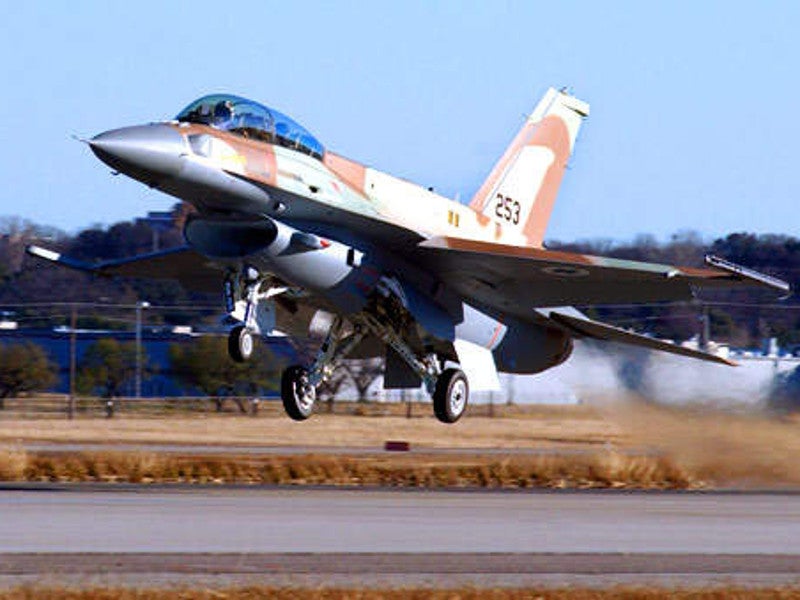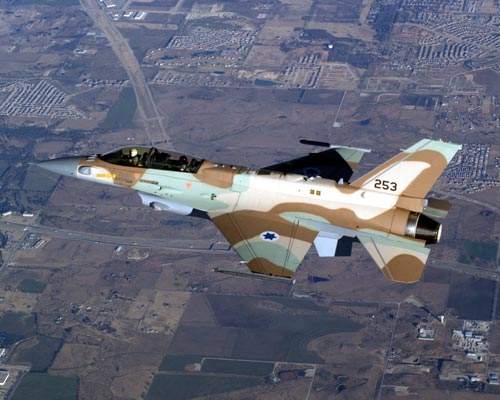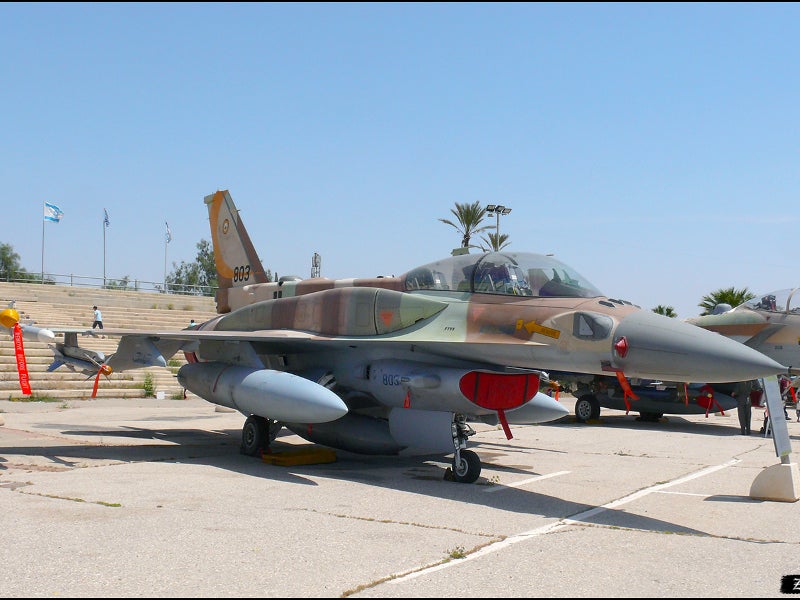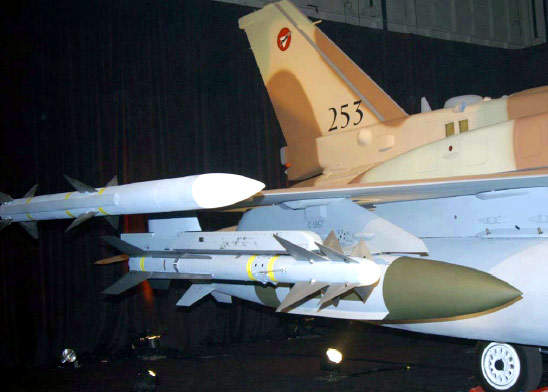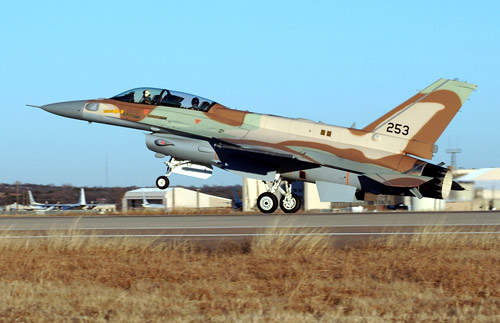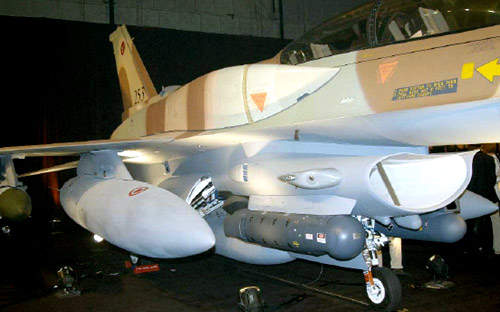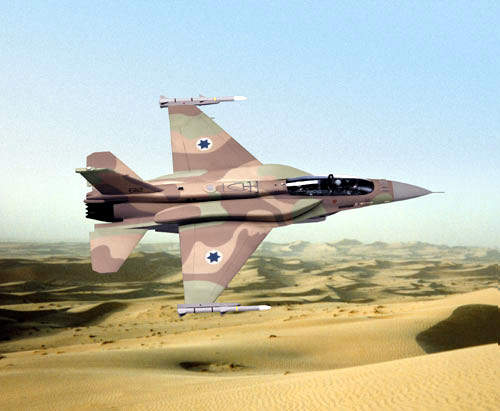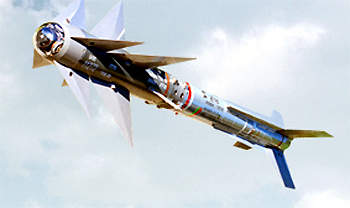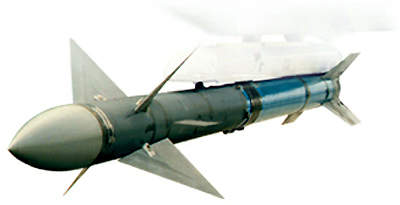F-16I Soufa (Storm) is a modified variant of the F-16D block 50 and 52 fighter and ground attack aircraft, with the avionics and weapons systems capability modified to meet the requirements of the Israeli Air Force. Israel ordered 50 F-16I aircraft in 2001 and signed the agreement for an optional additional 52 aircraft in September 2001. The Israeli Air Force has selected the F16I in a two-seat configuration only.
The production programme, called Peace Marble V, is the fifth acquisition of F-16s. It increased the number of Israeli Air Force F-16 aircraft to 362, giving the IAF the largest fleet of F-16 fighters apart from the US.
The F16I made its maiden flight in December 2003. The first two aircraft were delivered to the IAF at the Ramon Air Base, in February 2004. Deliveries were completed at a rate of about two a month over four years, with final delivery in 2009. There is a significant level of airframe co-production and avionics component production in Israel for the Soufa and for other variants of the F-16. IAI and Cyclone Aviation Products in Carmiel manufacture the ventral fins, rudders, horizontal stabilisers and engine access doors. The aircraft are assembled at the Lockheed Martin Aeronautics facility in Fort Worth, Texas.
In September 2009, the IAF temporarily grounded the F-16I from training operations after a jet experienced engine failure.
F-16I Soufa fighter design
The F-16I is fitted with a pair of removable conformal fuel tanks provided by IAI. The conformal fuel tanks (CFT), holding 450gal of extra fuel, are mounted on both sides of the upper fuselage. The very low drag configuration CFTs have a very small effect on the aircraft’s agility, handling quality and flight limits. The use of the conformal tanks increases the aircraft’s mission range and combat endurance.
The fitting of conformal tanks makes the two wing inner store stations normally used for external tanks (stations 6 and 4, each rated at 4,500lb capacity) available for weapon carriage, doubling the aircraft’s air-to-ground weapons capacity.
F-16I Soufa is fitted with a dorsal avionics compartment. The first version produced with the dorsal compartment was the Israeli two-seat block 30 F-16D aircraft, produced in the late 1980s. The large dorsal compartment extends from the rear of the cockpit to the fin and houses additional avionics systems, chaff and flare dispensers and the aircraft’s in-flight refuelling receptacle.
Cockpit
The front cockpit is for the pilot and the rear cockpit is configured for the weapons systems operator or, with the change of a single switch, for a pilot instructor.
The Elbit Dash IV display and sight helmet system enables the pilot to aim the weapon by looking the target. Dash IV shortens the lock-on procedure time for engagements. The helmet measures the pilot’s line of sight to the target so the sensors, avionics and weapons are slaved to the target. Dash IV improves situation awareness by helping the pilots to visually detect targets at high angles off the nose of the aircraft, providing critical information in any direction the pilot looks.
The F-16I is fitted with a wide angle head up display from Elop and high definition (120ppi) 4in x 4in colour multi-function displays supplied by Astronautics CA of Petah Tikva, Israel.
Other new features include a colour moving map display, digital video recording equipment, cockpit lighting and external strip lighting compatible with night vision goggles and a high capacity data transfer set.
F-16I Soufa fighter avionics
The aircraft has an advanced avionics suite including general avionics computer, colour display processors and interfaces all produced by Elbit Systems.
The communications systems include a Rafael UHF/VHF radio and an HF radio, Elta satellite communications and an IAI integrated tactical video data link.
The navigation system includes a combined ring laser gyro inertial navigation system and global positioning system (RLGINS/GPS) and a digital terrain system. Rafael developed the algorithms for the digital terrain system.
In June 2008, Elbit systems supplied the F-16I simulator system that is compatible with the aircraft avionics and cockpit.
Weapon systems
Elbit supplied the aircraft’s central mission computer, the signal processing unit for the displays and the stores management systems. RADA Electronics Industries in Netanya, Israel, and Smiths Aerospace, USA, have developed the aircraft’s data acquisition system with an advanced digital data server and data recording system. Israel Military Industries supplies most of the weapons pylons and racks and the external fuel tanks.
The mission data and video is downloaded to a ground debriefing station provided by RADA. The system has potential for three-dimensional, multi-aircraft mission creation.
The Rafael Litening II targeting and navigation pod is equipped with a third-generation forward looking infrared (FLIR), charge-coupled device (CCD) television, laser spot tracker and rangefinder and infrared marker. The system enables the pilot to detect, identify, acquire and track ground targets for the delivery of conventional and precision guided weapons, such as laser guided or GPS guided bombs.
The aircraft is also equipped with the Lockheed Martin LANTIRN navigation pod which provides night navigation and all-weather automatic terrain following.
Air-to-air missiles
The air-to-air missiles are the short range Python 4 and Python 5 and the short range to beyond visual range radar-guided Derby, both supplied by Rafael.
The all-weather Derby has an active radar seeker, look down / shoot down capability, lock on before or after launch, and programmable electronic counter countermeasures (ECCM). The lock on before launch mode is deployed for tight dogfights.
F16I is equipped with the Rafael Python 5 air-to-air missile. The Python 5 is capable of lock on after launch and uses imaging infrared guidance. The new seeker uses a dual wavelength focal plane array and is equipped with robust infrared counter countermeasures capability.
Air-to-ground systems
The air-to-surface weapons are carried on the two pairs of inboard underwing stations and include anti-ship missiles, anti-radiation missiles, laser guided bombs, GPS guided bombs and Israeli Military Industries (IMI) runway attack munitions. The F-16 aircraft has been used in carriage trials of IMI’s STAR-1 anti-radiation weapon which is in the development phase.
F-16I fighter countermeasures
The electronic warfare suite, being supplied by Elisra, includes radar warning receivers, missile approach warners, and jamming systems, including the Elisra SPS 3000 self-protection jammer, which is installed in the large spine. The chaff and flare dispenser is supplied by Rokar.
F-16I radar
The aircraft has the Northrop Grumman AN/APG-68(V)9 multi-mode radar, which has five times the processing speed and ten times the memory capacity of the previous APG-68 radars on the F-16. Elta is involved in the co-production of the radar.
The modes of operation include high resolution synthetic aperture (SAR) ground mapping and terrain following. The radar provides autonomous, all-weather, stand-off precision weapon delivery. Air-to-air modes include range while search, air combat mode, multiple target track while scan, cluster resolution, single target tracking and target illumination pulse Doppler tracking. The radar increases the air-to-air detection range by 30% compared to earlier generation systems.
Engines
The fighter is powered by the Pratt and Whitney F100-PW-229 increased performance engine (IPE). This new, more powerful engine allows the aircraft a maximum take-off weight of 23,582kg. The aircraft is also fitted with heavyweight landing gear.

